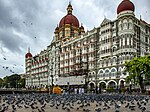Badhwar Park

Badhwar Park is the residential complex of the Indian Central Railway and Western Railway officers. It is located at Wodehouse Road in Cuffe Parade. The colony is situated along the coastline. The complex has been aptly named after Shri Fateh Chand Badhwar, the first Indian chairman of the Indian Railway Board. Shri Omprakash Rai is the IOW of Badhwar Park. In the past, after its inception in 1925, all chairmen of the Railway Board had been Britons. The beautiful, lush green complex has a club with sports facilities (two lawn tennis courts, two badminton courts, gymnasium, swimming pool, billiards and pool), library etc. The club has coaching facilities for many sports and martial arts. Badhwar Park can be reached from Churchgate or Chhatrapati Shivaji Terminus (CST) railway station by catching bus no 138 starting from CST (via Churchgate).
Excerpt from the Wikipedia article Badhwar Park (License: CC BY-SA 3.0, Authors, Images).Badhwar Park
Nathalal M. Parikh Road, Mumbai Zone 1 (Mumbai)
Geographical coordinates (GPS) Address Nearby Places Show on map
Geographical coordinates (GPS)
| Latitude | Longitude |
|---|---|
| N 18.921144444444 ° | E 72.827325 ° |
Address
Nathalal M. Parikh Road
Nathalal M. Parikh Road
400023 Mumbai, Zone 1 (Mumbai)
Maharashtra, India
Open on Google Maps








